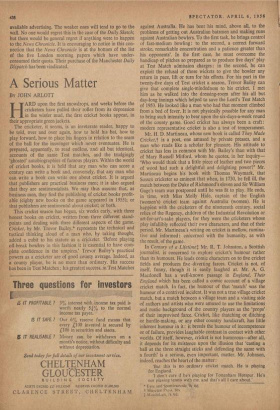A Serious Matter
BY JOHN ARLOTT HARD upon the first snowdrops. and weeks before the cricketers have pulled their roller from its depression in the winter mud, the first cricket books appear, in their appropriate green jackets.
The cricketer, it seems, is an inveterate reader, happy to be told, over and over again, how to hold his bat, how to play forward, how to place his fingers in relation to the seam of the ball for the inswinger which never eventuates. He is prepared, apparently, to read endless, and all but identical, accounts of the same Test matches, and the trudgingly `ghosted' autobiographies of famous players. Within the world of cricket books, it is held that any man who can score a century can write a book and, conversely, that any man who can write a book can write one about cricket. It is argued that publishers arc practical business men; it is also argued that they are sentimentalists. We may thus assume that, as business men, they find the publishing of cricket books profit- able (eighty new books on the game appeared in 1955); or that publishers arc sentimental about cricket; or both.
This cricket season has begun, six weeks early, with three honest books on cricket, written from three different stand- points and dealing with three different aspects of the game. Cricket, by Mr. Trevor Bailey.* represents the technical and tactical thinking aloud of a man who, by taking thought, added a cubit to his stature as a cricketer. 'Before playing off-break bowlers in this fashion it is essential to have com- plete confidence in the umpires.' Trevor Bailey's practical powers as a cricketer are of good county average. Indeed, as a county player, he is no more than ordinary. His success has been in Test Matches : his greatest success, in Test Matches against Australia. He has bent his mind, above all, to the problems of getting out Australian batsmen and making runs against Australian bowlers. To the first task, he brings control of fast-medium bowling : to the second, a correct forward stroke, remarkable concentration and a patience greater than his opponents'. In the first case, he must overcome the handicap of pitches so prepared as to produce five days' play. at Test Match admission charges : in the second, he can exploit the refusal of those wickets to give the bowler any return in pace, lift or turn for his efforts. For his part in the twenty-five days of Test cricket a season, Trevor Bailey can give that complete single-mindedness to his cricket. I met him as he walked into the dressing-room after his all but day-long innings which helped to save the Lord's Test Match of 1953. He looked like a man who had that moment climbed from a bed of fever. It is not physically possible for any man to bring such intensity to bear upon the six-days-a-week round of the county game. Good cricket has always been a craft : modern representative cricket is also a test of temperament.
Mr. H. D. Martineau, whose new book is called They Made Cricket,t is a poet, one amused by private presses, and a man who reads like a scholar for pleasure. His attitude to cricket has less in common with Mr. Bailey's than with that of Mary Russell Mitford, whom he quotes, in her inquiry— `Who would think that a little piece of leather and two pieces of wood had such a delightful and delighting power?' Mr. Martineau begins his book with Thomas Waymark, that Sussex cricketer so eminent that when, in 1730, he fell ill, the match between the Duke of Richmond's eleven and Sir William Gage's team was postponed until he was fit to play. He ends, in time, with Miss Molly Hide, captain of the English (women's) cricket team against Australia (women). He is happiest with the cricketers of the nineteenth century, social relics of the Regency, children of the Industrial Revolution or art-for-art's-sake players, for they were the cricketers whose play infallibly reflected their own characters, and that of their period. Mr. Martineau's writing on cricket is mellow, rumina- tive and informed : concerned with the humanity, as with the result, of the game.
In Century of a Lifetimes Mr. R. T. Johnston, a Scottish journalist, is concerned to explore cricket's hutnour rather than its humours. He leads comic characters on to five cricket fields and produces five diverting farces. Cricket is not, of itself, funny, though it is easily laughed at. Mr. A. G. Macdonell has. a well-known passage in England, Their England which has been called a comic account of a village cricket match. In fact, the humour of that 'match' was the humour of a contrived incident. It was not a true village cricket match, but a match between a village team and a visiting side of authors and artists who were amused to use the limitations and rustic background of the country players as the 'props' of their improvised farce. Cricket, like thatching or ditching or hurdle-making, or any other country handicraft, has little inherent humour in it : it breeds the humour of incompetence or of failure, provides laughable contrast in contact with other worlds. Of itself, however, cricket is not humorous—after all, it depends for its existence upon the illusion that 'casting a ball at the three straight sticks and defending the same with a fourth' is a serious, even important, matter. Mr. Johnson, indeed, reaches the heart of the matter :
Tut this is no ordinary cricket match. He is playing for England.'
'I don't care if he's playing for Tottenham Hotspur. He's not playing tennis with me and that's all I care about.'
* Eyre and Sponiswoode. 9s od. t Museum Pre.ss. los Mac.nil.dn, 7s. W.
















































 Previous page
Previous page